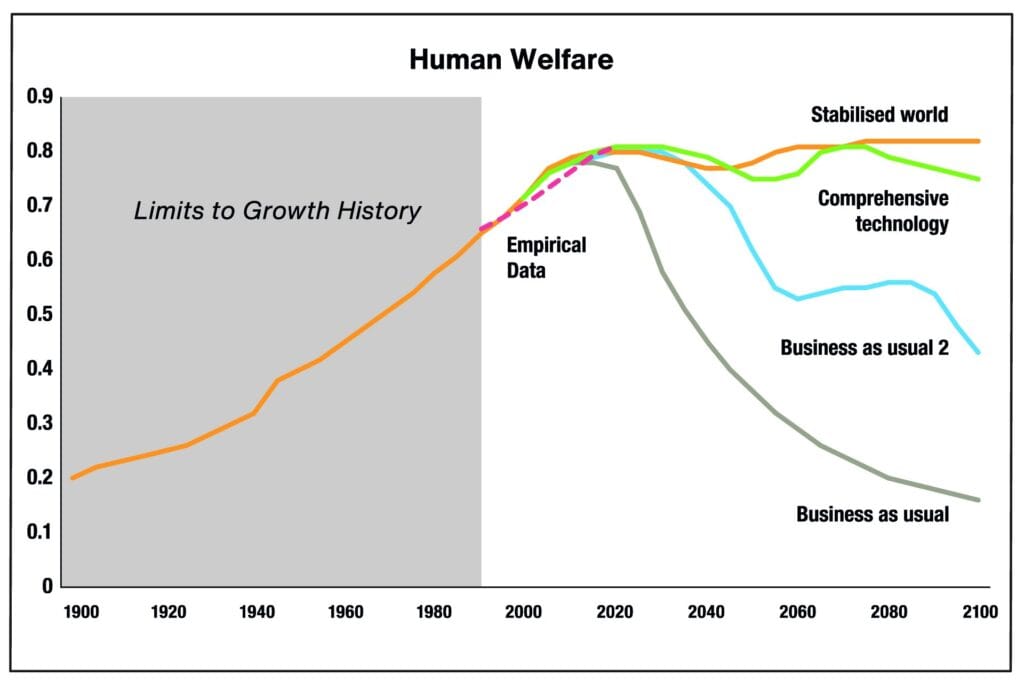My research went viral last summer. I found out via a friend’s text, jokingly accusing me of “announcing the end of the world.” For several days, headlines on major US news pages declared that my research proved we are on the brink of collapse. A few days later, UK pages touted the same headlines. Then I saw my name popping up in languages I do not know, from Swedish, to Greek, to Chinese, to Sinhala.
It took me a bit by surprise. My research had been published months earlier, in November 2020. Also, it was a data comparison of a model from a book that was almost half a century old. Apart from the headlines being a simplistic version of my research’ message, they also gave the impression that the possibility of societal collapse suddenly had been revealed. But this warning was a key message of The Limits to Growth (LtG) book, which the authors Meadows, Meadows, Randers & Behrens, published back in 1972. In LtG, commissioned by the Club of Rome, the authors identified society’s relentless pursuit of growth not as the solution to, but the cause of, so many of the environmental and social crises that plague humanity still today. Their analysis was based on a global model called World3. The authors created different scenarios by varying World3’s underlying assumptions. This scenario analysis helped them study global dynamics between variables including industrial output, resources, pollution, and living standards. In my research, I compared four LtG scenarios against a few decades of empirical data. Details about the scenarios methods and results, can be found in my article in Yale’s Journal of Industrial Ecology. An easier read with the gist of my findings was also published on the Club of Rome website. Here, I’ll just share my conclusions, illustrated by a graph of the variable people might be most concerned with: living standards (Figure 1). This graph is from my upcoming book Five Insights for Avoiding Global Collapse, soon available online under Creative Commons, which contains further research analysis and 2022 data update of my comparison.

I found an overall close alignment of empirical data with the scenarios, for now, because they only diverge significantly after 2020. This accuracy decades into the future gives reason to take the World3 dynamics seriously. If we do that, we unfortunately must conclude that the future holds risks of declines in welfare, among other things, and some of these declines are indeed steep enough to constitute a collapse. The scenario indicated with “SW” shows no collapse and the highest living standards. However, empirical data aligned least closely to SW.
I interpret all this as humanity having a now or never opportunity to change direction. Contrary to what my friend texted me, I did not predict the end of the world, just like LtG didn’t at the time; I noticed warning signals and voiced a call to action. Empirical data are not far from SW yet, and humankind can determine where future data points fall. How? Well, there is one key difference between SW and the other scenarios: in SW, humanity consciously lets go of growth as its goal. Under SW assumptions, society shifts priorities away from industrial output growth towards resource efficiency, pollution abatement, and health and education services. We can do that in the real world too.
Will we? Before you answer that question in your head, let’s frame it properly. Because this is not about whether we want to avoid collapse; it’s whether we want better. SW represents a redesign of society away from material consumption, around human and ecological wellbeing. Yes, that would take a lot of effort. But we’d also be working on healing society, towards a future of thriving. Does that sound to you like something worth putting in work for?
If so: good news. At LtG’s 50-year anniversary, the Club of Rome will publish a follow-up called Earth for All: A plan for global wellbeing on a healthy planet. This new book describes how to launch society into a sustainability transformation. The book is still realistic in that it foretells that what we do in the next decade will determine our livings standards for the rest of this century. But even more, it’s a vision for a better world. We need to act fast, yes, but we are not out of time yet to turn society around. And not only are we capable of making this change; we are yearning for it. A world for all where life can flourish indefinitely will be so much more than just a society that avoided societal collapse. It will have been so much worth the effort.
References
Dixson-Declève, S., Stoknes, P. E., Gaffney, O., & Ghosh, J. (2022). Earth for All: A plan for global wellbeing on a healthy planet. A report to The Club of Rome. New Society.
Herrington, G. (2022). Five insights for avoiding global collapse. Basel, Switzerland: MDPI Publishing
Herrington, G. (2021). Update to limits to growth: Comparing the World3 model with empirical data. J Ind Ecol, 25(3), 614– 626. https://doi.org/10.1111/jiec.13084
Meadows, D. H., Meadows, D. L., Randers, J., & Behrens, W. W. (1972). The limits to growth: A report for the Club of Rome’s project on the predicament of mankind. Universe Books



